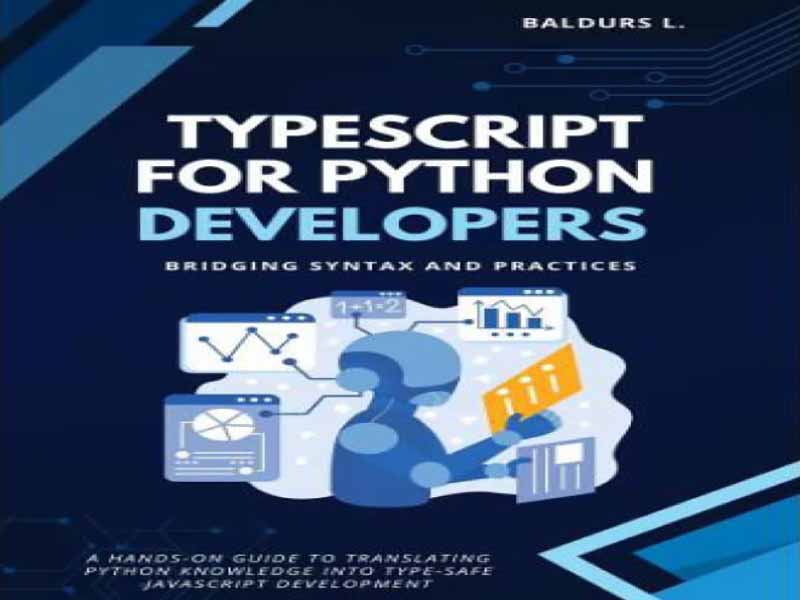- عنوان کتاب: TypeScript for Python Developers Bridging Syntax and Practices
- نویسنده: Baldurs L
- حوزه: Typescript
- سال انتشار: 2025
- تعداد صفحه: 332
- زبان اصلی: انگلیسی
- نوع فایل: pdf
- حجم فایل: 1.19 مگابایت
به عنوان یک توسعهدهنده پایتون، شما ظرافت نوشتن کد تمیز و خوانا با تایپ پویا را که تقریباً محاورهای به نظر میرسد، تجربه کردهاید. شما از آزادی نمونهسازی سریع، رسایی درک لیستها و سادگی سینتکس پایتون که اغلب مانند زبان طبیعی خوانده میشود، لذت بردهاید. اکنون، شما در آستانه TypeScript ایستادهاید – زبانی که نوید میدهد شکاف بین انعطافپذیری پویای مورد علاقه شما و ایمنی نوع استاتیک مورد نیاز توسعه وب مدرن را پر کند. این سفر در مورد کنار گذاشتن اصولی نیست که شما را به پایتون جذب کرده است؛ بلکه در مورد کشف این است که چگونه TypeScript بسیاری از همان فلسفهها را در بر میگیرد و در عین حال لایههایی از قابلیت اطمینان و ابزاری را اضافه میکند که میتواند تجربه توسعه شما را متحول کند. TypeScript نشان دهنده تلاش بلندپروازانه مایکروسافت برای آوردن ساختار و قابلیت پیشبینی به غرب وحشی جاوا اسکریپت است، بسیار شبیه به نحوهای که پایتون در اوایل دهه 1990، وضوح و سادگی را به برنامهنویسی آورد. وقتی Guido van Rossum پایتون را خلق کرد، بر خوانایی و سادگی با اصل معروف “باید یک راه واضح برای انجام آن وجود داشته باشد” تأکید کرد. تایپاسکریپت، اگرچه در یک اکوسیستم متفاوت عمل میکند، اما شباهتهای فلسفی شگفتانگیزی با پایتون دارد که آن را به گام بعدی طبیعی برای توسعهدهندگان پایتون تبدیل میکند. هر دو زبان، تجربه توسعهدهنده و بهرهوری را در اولویت قرار میدهند. پایتون این امر را از طریق سینتکس تمیز و فلسفه «باتریهای گنجانده شده» خود محقق میکند، در حالی که تایپاسکریپت از طریق استنتاج نوع هوشمند، ابزار جامع و استراتژیهای پذیرش تدریجی به اهداف مشابهی دست مییابد. وقتی پایتون مینویسید، اغلب خود را در حال فکر کردن به شکل و ساختار دادههای خود میبینید – اینکه یک شیء چه ویژگیهایی باید داشته باشد، یک تابع چه نوع مقادیری را باید بپذیرد. تایپاسکریپت این افکار ضمنی را صریح میکند و یک شبکه ایمنی فراهم میکند که خطاها را قبل از رسیدن به مرحله تولید، شناسایی میکند.
As a Python developer, you’ve experienced the elegance of writing clean, readable code with dynamic typing that feels almost conversational. You’ve enjoyed the freedom of rapid prototyping, the expressiveness of list comprehensions, and the simplicity of Python’s syntax that often reads like natural language. Now, you’re standing at the threshold of TypeScript—a language that promises to bridge the gap between the dynamic flexibility you love and the static type safety that modern web development demands. This journey isn’t about abandoning the principles that drew you to Python; it’s about discovering how TypeScript embraces many of the same philosophies while adding layers of reliability and tooling that can transform your development experience. TypeScript represents Microsoft’s ambitious attempt to bring structure and predictability to JavaScript’s wild west, much like how Python brought clarity and simplicity to programming when it emerged in the early 1990s. When Guido van Rossum created Python, he emphasized readability and simplicity with the famous principle that “there should be one obvious way to do it.” TypeScript, while operating in a different ecosystem, shares a surprising number of philosophical similarities with Python that make it an natural next step for Python developers. Both languages prioritize developer experience and productivity. Python achieves this through its clean syntax and “batteries included” philosophy, while TypeScript accomplishes similar goals through intelligent type inference, comprehensive tooling, and gradual adoption strategies. When you write Python, you often find yourself thinking about the shape and structure of your data—what properties an object should have, what types of values a function should accept. TypeScript makes these implicit thoughts explicit, providing a safety net that catches errors before they reach production.
این کتاب را میتوانید از لینک زیر بصورت رایگان دانلود کنید:
Download: TypeScript for Python Developers Bridging Syntax and Practices




































نظرات کاربران